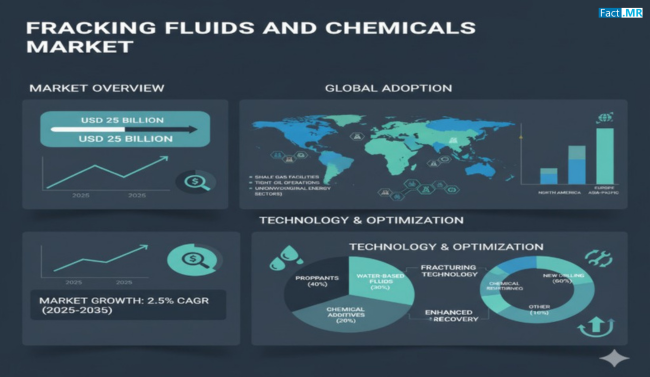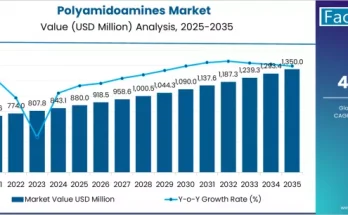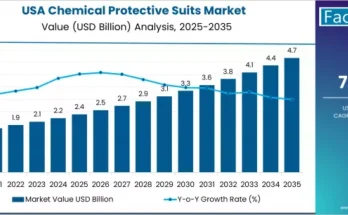The fracking fluids and chemicals market is experiencing dynamic growth as the energy sector increasingly relies on hydraulic fracturing for the extraction of oil and natural gas from unconventional reservoirs. Fracking fluids, which comprise water, proppants, and specialized chemicals, are essential for enhancing well productivity, minimizing environmental impact, and ensuring operational efficiency.
With the rising global demand for energy, technological advancements, and the push for more efficient extraction techniques, the fracking fluids and chemicals market is evolving rapidly. The focus on environmentally responsible formulations and performance-optimized products underscores the importance of innovation in this sector.
Market Overview:
Fracking fluids are engineered to create fractures in subsurface rock formations, allowing hydrocarbons to flow freely to the surface. Chemicals within these fluids serve multiple purposes, including viscosity control, corrosion inhibition, friction reduction, and microbial prevention. The choice and concentration of chemicals are critical to optimizing well performance while mitigating operational and environmental risks.
The market is driven by a growing emphasis on efficiency, cost-effectiveness, and safety in hydraulic fracturing operations. Manufacturers are investing in high-performance additives, biodegradable formulations, and environmentally friendly solutions that reduce ecological impact without compromising productivity. Advances in fluid design, such as gel-based, slickwater, and foam fluids, provide operators with versatile options tailored to different geological conditions.
Regional Insights:
North America leads the fracking fluids and chemicals market due to the extensive development of shale formations and the maturity of hydraulic fracturing technology. Regulatory oversight and the emphasis on environmental compliance have fostered the adoption of advanced, safer chemical formulations.
Europe is experiencing cautious growth, driven by energy diversification efforts, stricter environmental regulations, and limited shale gas development. Research and pilot projects are influencing the adoption of innovative fluids with lower ecological impact.
Asia-Pacific is emerging as a significant market, with increasing exploration activities and investment in unconventional oil and gas resources. Countries such as China and Australia are exploring shale gas and tight oil reservoirs, creating demand for advanced fracking fluids and chemical solutions.
Latin America and the Middle East & Africa are gradually expanding the use of hydraulic fracturing, supported by favorable energy policies and investment in upstream oil and gas infrastructure. Adoption in these regions is focused on optimizing extraction while adhering to environmental standards.
Innovations and Regulatory Trends:
Innovation in fracking fluids and chemicals focuses on improving efficiency, reducing environmental risks, and enhancing operational safety. Biodegradable and non-toxic additives are increasingly preferred to minimize ecological footprint and meet regulatory requirements. Advanced formulations are being developed to improve fracture propagation, proppant transport, and chemical stability under extreme subsurface conditions.
Regulatory frameworks are shaping the market significantly. Governments are emphasizing chemical disclosure, water management, and environmental monitoring to ensure responsible hydraulic fracturing practices. Compliance with local and international standards encourages the development of safer, more transparent, and sustainable chemical solutions.
Key Trends & Forecast:
Several trends are transforming the fracking fluids and chemicals market:
- Focus on Environmental Sustainability: Rising pressure from regulators, stakeholders, and communities is driving demand for biodegradable and eco-friendly chemical formulations.
- High-Performance Additives: Engineers are prioritizing fluids with enhanced viscosity, thermal stability, and proppant-carrying capacity to improve well productivity.
- Technological Integration: The integration of real-time monitoring, fluid analysis, and data-driven optimization is enhancing operational efficiency and safety.
- Water Management Solutions: Efforts to reduce water consumption, recycle fluids, and minimize contamination are influencing product development.
- Regional Adaptation: Tailoring fluid formulations to specific geological and regulatory conditions ensures optimized performance across diverse reservoirs.
These trends highlight the market’s commitment to efficiency, sustainability, and operational excellence in hydraulic fracturing operations.
Applications & End-Use Outlook:
Fracking fluids and chemicals are integral to several applications within the oil and gas sector:
- Unconventional Oil and Gas Extraction: Essential for shale gas, tight oil, and coalbed methane extraction to increase hydrocarbon flow and recovery rates.
- Well Stimulation and Productivity Enhancement: Chemicals improve fracture propagation, proppant transport, and reduce operational downtime.
- Industrial Water and Chemical Management: Formulations support fluid recycling, minimize corrosion, and control microbial growth to ensure well integrity.
- Energy Infrastructure Development: Fracking fluids play a key role in expanding upstream energy production capabilities and meeting growing energy demands.
The versatility of fracking fluids and chemicals across these applications demonstrates their critical role in modern energy exploration and production.
Competitive Landscape:
The fracking fluids and chemicals market is highly competitive, with global chemical manufacturers and specialized regional players striving to deliver innovative, high-quality solutions. Companies focus on research and development to create sustainable, performance-driven formulations while maintaining cost-effectiveness.
Strategic partnerships with oilfield service providers, chemical distributors, and research institutions are enabling faster adoption of advanced technologies and formulations. Branding, regulatory compliance, and consistent product quality remain crucial differentiators in this highly specialized market.
Conclusion:
The fracking fluids and chemicals market is poised for steady growth as the oil and gas industry continues to optimize unconventional resource extraction. With innovations in fluid formulations, environmentally friendly chemicals, and technology-driven operational solutions, the market is advancing toward safer, more efficient, and sustainable hydraulic fracturing practices.
Companies that prioritize innovation, regulatory compliance, and environmental responsibility are well-positioned to capitalize on the evolving needs of the energy sector. The future of the fracking fluids and chemicals market lies in balancing productivity, safety, and ecological stewardship to meet global energy demands.
Browse Full Report – https://www.factmr.com/report/493/fracking-fluid-market



